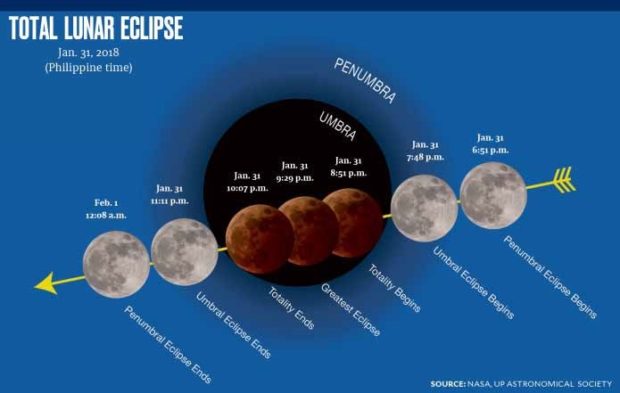
The moon’s copper color during the eclipse is expected to appear more stark as the suspended dust from the volcano’s eruption may act as a “filter,” making the red color appear deeper, said Mario Raymundo, chief of the Pagasa Astronomical Observation and Time Service Unit.
Good weather is forecast for Albay province on Jan. 31, according to Robert Sawi, Pagasa assistant weather services chief.
Observation stations
Stargazers hoping to get a closer glimpse of the super blue blood moon may head to observation stations to be put up in various parts of the country.
Telescopes will be available to the public at the stations free of charge.
The stations, the locations of which have been posted by Philippine Astronomical Society Inc., highlight the excitement generated by the astronomical trifecta.
In Metro Manila, viewers may make their way to the following areas:
Manila: Rizal Park from 6 p.m. to midnight and San Beda College from 6 p.m. to 10 p.m.
Quezon City: SM North Edsa from 7 p.m. onward, the Astronomical Observatory at UP Diliman from 6 p.m. to 12:10 a.m. and Trinoma Park from 6:30 p.m. to 9 p.m.
San Juan City: Pinaglabanan Shrine from 6 p.m. to midnight.
Pasay City: SM by the Bay Central Park at SM Mall of Asia from 6 p.m. to midnight.
Muntinlupa City: Alabang Town Center from 6 p.m. to midnight.
Other viewing sites
In Cavite province, viewers may witness the super blue blood moon at SunTech iPark Lancaster Square New City from 7 p.m. to 10 p.m.
In Laguna province, stargazers may make their way to Sampaloc Lake Park, San Pablo City, from 7:30 p.m. to 10 p.m. or the Carabao Park, UP Los Baños, from 7 p.m. to 10 p.m.
In Batangas province, the public may go to Kapusod at Sitio Kinalaglagan, Mataas na Kahoy, from 7 p.m. to 11 p.m.
Cebuanos may view the celestial event at Indiana Aerospace University Sports Arena from 7 p.m. to midnight.
Three lunar events
Davaoeños may watch the spectacle at Abreeza Ayala Mall, Davao City, from 7 p.m. to 10 p.m.
The super blue blood moon refers to the simultaneous occurrence of three lunar events: the blue moon, supermoon and lunar eclipse.
A blue moon refers to the second full moon of the month. The moon on Wednesday night will actually be blood red due to sunlight reflected by the Earth’s atmosphere during the lunar eclipse.
A supermoon happens when the moon comes within at least 361,000 kilometers from the Earth. The moon will be 358,995 km from Earth at 9:27 p.m. on Wednesday, making it appear 14 percent larger and 30 percent brighter than usual.
Peak
The lunar eclipse will begin at 6:49 p.m. and reach its peak at 9:29 p.m. A partial eclipse can still be viewed at 11:11 p.m. The penumbral eclipse will end by 12:09 a.m. on Feb. 1.
The moon itself will rise at 5:42 p.m. on Wednesday and set at 6:47 a.m. the next day, according to Pagasa.
The Pagasa Astronomical Observatory will also livestream the event on its Facebook page.
In a press briefing on Monday, Pagasa said the super blue blood moon was last seen in the Philippines 36 years ago on Dec. 30, 1982. Earlier news reports said the phenomenon last occurred in North America some 150 years ago.
Pagasa has forecast light to moderate rains over northeastern Luzon. The rest of the country is forecast to experience partly cloudy to at times cloudy with passing light rains. —Reports from Jaymee T. Gamil and Matthew Reysio-Cruz